How the media - and all those wanting to be
on the politically correct side of the fence -
hyped a fake 'racist' episode to eclipse
the 46th March for Life success in DC
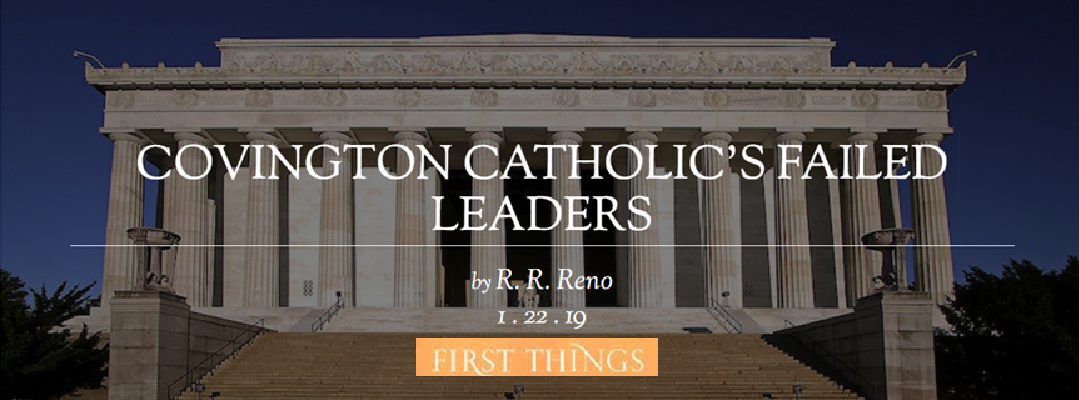
Shame on our Catholic and conservative leaders. Many of them joined the cyber-lynching of their own young followers. It’s a sad sign of our times. Overwrought with anxiety about their roles in elite society, they’ll sing any anti-racist tune taken up by the mainstream press, even at the expense of those who look to them for leadership.
Some high school boys took a long bus ride to Washington, D.C., to the March for Life, demonstrating their commitment to the sanctity of life. They were from Covington, Kentucky, a town on the Ohio River that’s seen its share of de-industrialization — Trump country. Some wore MAGA hats, proudly signaling their support for the president.
The March ends. They’re on the steps of the Lincoln Memorial, waiting for their bus to return home. A group known as the Black Israelites is nearby, insulting bystanders in a generalized fashion. Their attention falls on the schoolboys.
- “Get your racist Make America Great Again hats out of here.”
- “You crackers are traitors.”
- “All of you have school shooter haircuts.”
The boys start chanting school cheers in response. A Native American, Nathan Phillips, approaches them, beating his drum. The kids respond with cheers that make them sound like Florida State football fans.
After this episode, the Black Israelites continue their rant and the boys begin to banter with them. Taunts are exchanged. The leader of the Black Israelites gives them a parting shot: “Your president is a homosexual.” Laughter ensues. Evening falls. The boys depart.
I urge folks to view the long video of the encounter.
https://nypost.com/2019/01/21/longer-video-casts-new-light-on-native-american-taunting-controversy/
The scenes are heartening, a testimony to the ways in which our crazy-quilt country gets along reasonably well.
- The Black Israelite street preacher is a well-known American type, haranguing the passersby.
- A skateboarder with headphones makes an appearance — a more recent figure in our urban landscape.
And the schoolboys from Covington are in good spirits, obviously enjoying the opportunity to play their role in the street Kabuki that unfolds.
But as we all know, that’s not what the press reported.
An unknown person posted a short clip of the moment when the Native American activist Nathan Phillips goes face-to-face with the students. The media picked it up, saying that the white teenagers had “mobbed” him. A hate crime! The media seized on this account, promoting a cascade of denunciations.
I can understand why a liberal commentator might jump on this false story.
- It’s politically useful to depict Trump as a racist who is “dividing” the country.
- The people who support him are not worthy fellow citizens with concerns about the common good. They, too, are racists and “haters” of one sort or another.
- The kids from Covington are therefore useful pawns in the ongoing battle to show that the Trump administration is illegitimate, besmirching everything true, good, and beautiful about America.
But I was shocked by how rapidly Catholic and conservative leaders jumped into the denunciation competition, which soon reached Olympic proportions.
Here is the statement from Covington Catholic High School and the diocese of Covington under the leadership of Bishop Roger Foys:
We condemn the actions of the Covington Catholic High School students toward Nathan Phillips specifically, and Native Americans in general, Jan. 18, after the March for Life, in Washington, D.C. We extend our deepest apologies to Mr. Phillips. This behavior is opposed to the Church’s teaching on the dignity and respect of the human person. The matter is being investigated and we will take appropriate action, up to and including expulsion.
It’s a shocking statement from people who know the young men involved and who are responsible for their flourishing.
- Before hearing the whole story and determining how events actually unfolded, they too are willing to join the social media stampede.
- They identify their own young people as potential racists and moral criminals unworthy of membership in their community.
Joseph Kurtz, archbishop of nearby Louisville, added his voice to the chorus of condemnation.
“I join with Bishop Foys in condemning the actions of the Covington High School students toward Mr. Nathan Phillips and the Native American Community yesterday in Washington.”
We’re a long way from the spirit of John Hughes, New York’s first archbishop. He was a fierce advocate of the immigrant Catholics under his care, defending them against the condemnations of the Protestant elite. - Now we seem to have a Church in which kids who go to parochial schools aren’t protected.
- Their school principals and bishops prefer to condemn them rather than defend them.
- If there’s the slightest risk of getting sideways with establishment opinion, they’re thrown under the bus.
And of course there were the conservative pundits and leaders who rushed to add their names to the list of righteous prosecutors. This has been going on since 2016. They are often at the side of liberal elites. White teenage boys with MAGA hats? They’re racists — “deplorables.” That’s how the mainstream narrative trains them to tell the story, which they seem happy to do.
The Covington Catholic affair was small but telling. We are at a difficult juncture.
- The people who present themselves as mentors and leaders of the kids who were on the steps on the Lincoln Memorial listening to the crazy and fascinating rants of Black Israelites are anxious —too often about themselves and their reputations, not those under their care.
- They’re beholden to fears that they, too, will be accused of racism.
- So the rush to defend themselves and their institutions — at the cost of the reputations and wellbeing of the very people they claim to serve.
Of course we should be against racism and other forms of discrimination. But we need to wake up and face reality.
- In 2019, the rhetoric of anti-racism is used to discredit, destroy, and gain political advantage.
- It is not a societal norm we can uphold together. Catholic and conservative leaders who think otherwise are kidding themselves.
It’s time to put an end to our complicity in the bigot-baiting racket.
- It leverages the denunciation of hate crimes, real and imagined, into moral prestige and social standing among the “respectable” and “responsible.”
- We need to support those whom we mentor, guide, and lead.
- At the very least we need to remain silent and do no harm when the “respectable” are unleashing their ritual denunciations.
-
We should presume the innocence of ordinary people, not assume their guilt, actively defending them when the facts show they are deliberately targeted and falsely accused.
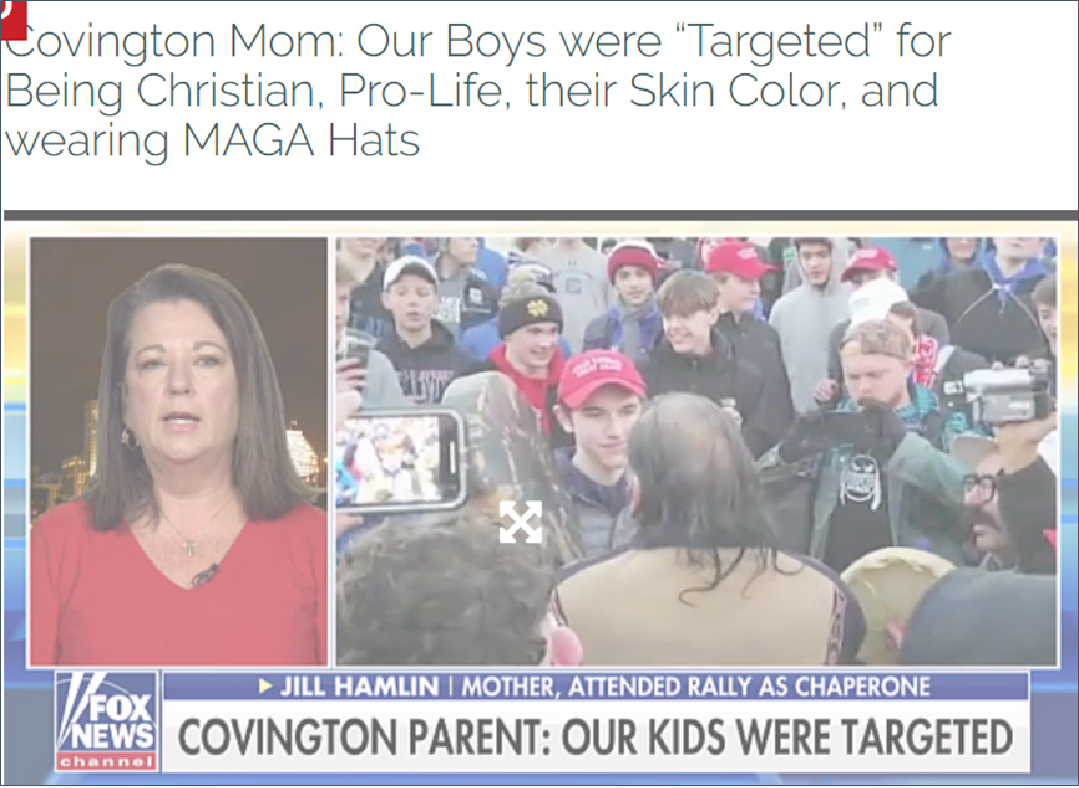 Analysis of a debacle
Analysis of a debacle
Shame on the diocese and the school for rushing to judgment, especially in this Pope Francis era of 'Who am I to judge?'
by Fr. Peter M.J. Stravinskas

January 22, 2019
For the past several days, my phone and email have been hyperactive as I have been asked by dozens of people for my “take” on the firestorm surrounding a group of students from Covington Catholic High School following the March for Life in Washington, D.C., last Friday.
I have been contacted because most know that I have spent my entire priestly ministry in Catholic education, actually beginning to teach high school while still a college seminarian. Not without reason, then, am I often introduced at Catholic school events as “Father Catholic Education.”
So, what did/do we know? It is somewhat like
A Tale of Two Cities.
Scenario A:
A group of high school boys disrespected a Native American man with a drum.
Scenario B: Act One: The boys, fresh from the March for Life, go to the Lincoln Memorial and wait for their bus to take them home. While there, they are confronted by a hostile, vile group of black supremacists who hurl at them anti-Catholic, anti-white, anti-gay and anti-American slogans – even calling the two black boys from the school “niggers”.
This activity goes on for nearly two hours.

Act Two: A Native American man interposes himself between the hostile black agitators and the “CovCath” kids, getting directly into the face of one of the boys – who “smirks.”
- Within nano-seconds, the media is all over the story, reporting Scenario A:
Catholic high school boys, in D.C. to work against women’s reproductive rights, are also racists.
- In short order, the administration of the school and the Diocese of Covington get on board and condemn the boys, even threatening expulsion.
- As real “facts”and video emerge, the story moves in the direction of Scenario B, causing some media outlets to apologize, including Jake Tapper of CNN.
- Even the peripatetic Father James Martin expressed a willingness to apologize; perhaps when he heard the anti-gay slurs from the black supremacists, he changed his mind!
Five observations:
1. Shame on the Diocese and the school for rushing to judgment, especially in this Pope Francis era of “Who am I to judge?”
- In this terrible time of instantaneous “news,” have we not learned to keep our counsel until a full picture develops?
- How many police officers have been unjustly condemned by rash evaluations, only to be vindicated when full, unedited videos become available?
- More to the point: As a former high school teacher and administrator, I have no delusions about the sanctity of teenagers. However,
I always made a presumption of innocence (isn’t that a basic ten
et of American jurisprudence?), but was likewise confident in the human and Christian formation to which my students had been exposed. I was able to troop them around the country and even Europe with nary a care about their conduct.
If “CovCath” felt compelled to believe the worst about their kids, what does it say about their level of confidence in what they have taught those young men and what those students have or have not absorbed? I would be happy to offer their faculty and administration one of my popular workshops on Catholic identity!
When the media contacted the school and the Diocese, an appropriate and fair response would have been: “We have no comment at present, pending a full investigation of the episode.” Period. And no fair-minded reporter could have balked at that.
2.
Why were some of the boys wearing MAGA hats? To be sure, there is nothing immoral about the hats, but they are unnecessarily provocative, skewing the pro-life cause in the minds of an already-negative culture.
- If the boys were in the nation’s capital to learn, first-hand, about American civics, it would have behooved adults to tell them that
we don’t need to be “in your face” to win a cause; truth be told,
the pro-life movement has gotten as far as it has (and it has gotten very far, largely due to now two generations of Catholic school students), precisely because we have always taken the high road, which has always infuriated the proponents of the Culture of Death.
I am a Trump supporter (albeit at times a reluctant one) but would not have worn a MAGA cap to the March and, as a principal, would not have allowed my students to do so, either.
[It probably would have been more prudent for the boys to have worn their Covington high school caps instead of the MAGA caps, but who knew they would run into any flak and be ambushed while waiting for the bus to take them home after the march? They travelled to Washington to meet up with tens of thousands like them who oppose the culture of death, and though there may have been many among the pro-life marchers who oppose Trump or do not like him, the great majority of them at least appreciate that he has consistently talked the talk and walked the walk on pro-life issues. So who among them could possibly be offended by a MAGA cap? MAGA cap or not, those Covington boys would have been heckled anyway and deliberately provoked by 'enemy forces' just because they were pro-life to begin with, Catholic to boot, and even worse, white boys in the era of the stupid mindset 'Black lives matter' - as if white lives or brown lives or yellow lives don't.]
3.
Where were the chaperones? Some adults were clearly present since the boys asked their permission to chant the school fight song – and got it from someone. The very minute that the black racists started in on the boys, I would have said, “Guys, let’s go. We’re out of here!” Instead, they allowed the situation to escalate for nearly two hours! They did not teach the boys how to handle a bad situation and actually endangered their welfare.
[It seems that the chaperones included parents of these children. Easy to say 'Let's get out of here', but how and where to? The situation developed because the Covington contingent had to wait for the buses that would take them home. They obviously were where they were supposed to wait for the buses. Without their means of transportation, it would have been a logistical nightmare for any adult to try to improvise an escape from the hecklers, who would surely have found a way to pursue and hound their victims if the latter had tried to 'flee'.]
If those chaperones were faculty or staff, they should be terminated. If they were parents, they should never again be given a position of trust.
4.
The Native American activist certainly did not enter the fray to de-escalate the impending crisis; he went to agitate (as his unfolding history now demonstrates).
- He has the temerity to say that he felt threatened by the boys, when it was he who marched into their midst, coming within inches of Nick Sandmann’s face.
- Had a white supremacist done that to a Native American or African American boy, all hell would have broken loose in the mainstream media.
[But because the 'victim' was Whitey, and the attackers were privileged politically correct minorities, the media were obviously cheering for the attackers. Hey, world, you see how protective we are of our minorities? If there is any confrontation at all, it would be because Whitey started it. Who do these white people think they are, anyway? In the America of 'black lives matter', they are even less than crap!]
5.
The “Statement of Nicholas Sandmann” is a powerful account of the unfolding of events, with every detail corroborated by subsequent audio and video; indeed, none of it shows any wrong behavior by the kids: not a hint of malice or prejudice, even under fire.
I must say that as impressed as I am by the “Statement,” my long years in high school work cause me to question that the document was written by a sixteen-year-old! It would have been better to call it a “Statement on Behalf of Nicholas Sandmann.”
[But Father, it says at the end of the statement that it comes from the Sandmann family. Who must be commended for having the poise and presence of mind to think of issuing such a statement, and for the masterful simplicity of its narrative. Perhaps someone in the family is a professional writer or even PR man, or the family knows someone who is, and wisely asked their help.] [
COLORE=#0026FF][P.S. The Sandmanns did use a professional PR service for the statement. Good for them.]
Where do we go from here?
The school sent the boys to Washington to advocate for justice for the unborn, and it should be praised for that.
- Unfortunately, the kids themselves didn’t get justice from the anti-life media and, even more sadly, from many in their own Church.
In this professional educator’s opinion, how should this be resolved?
- The Diocese and school ought to apologize to the boys.
- I think the adults present should get the axe. But I’m not holding my breath.
It is worth reading Nicholas Sandmann's account:
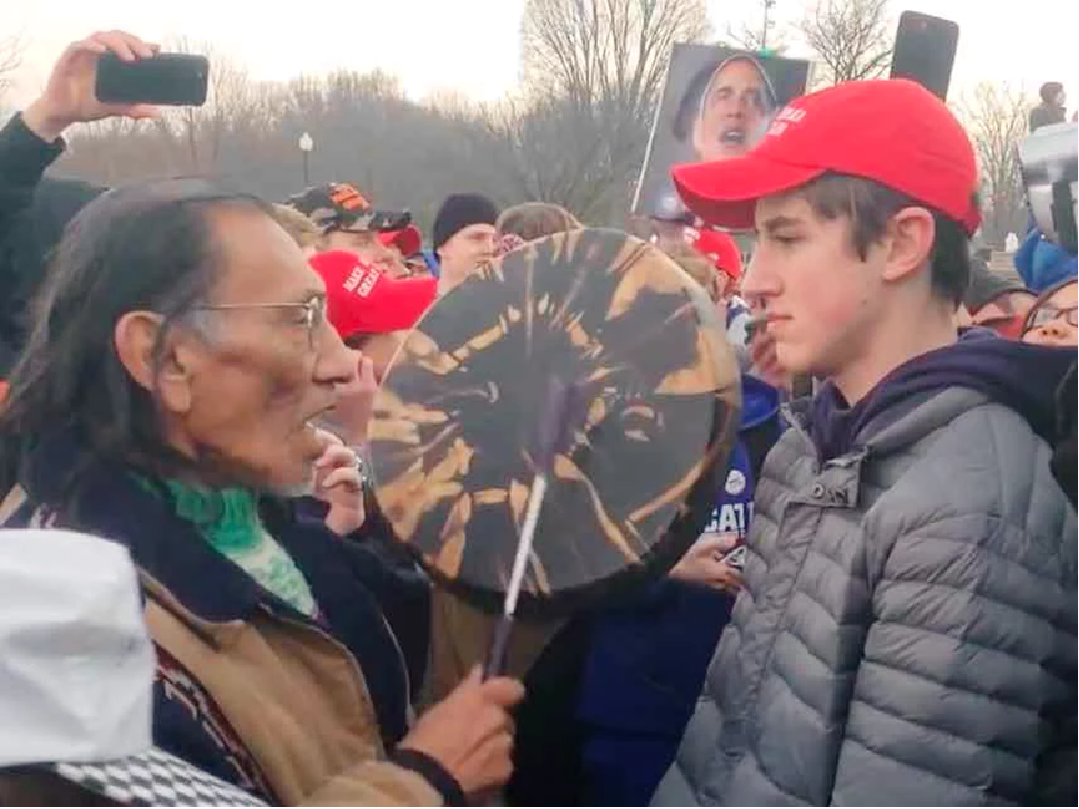
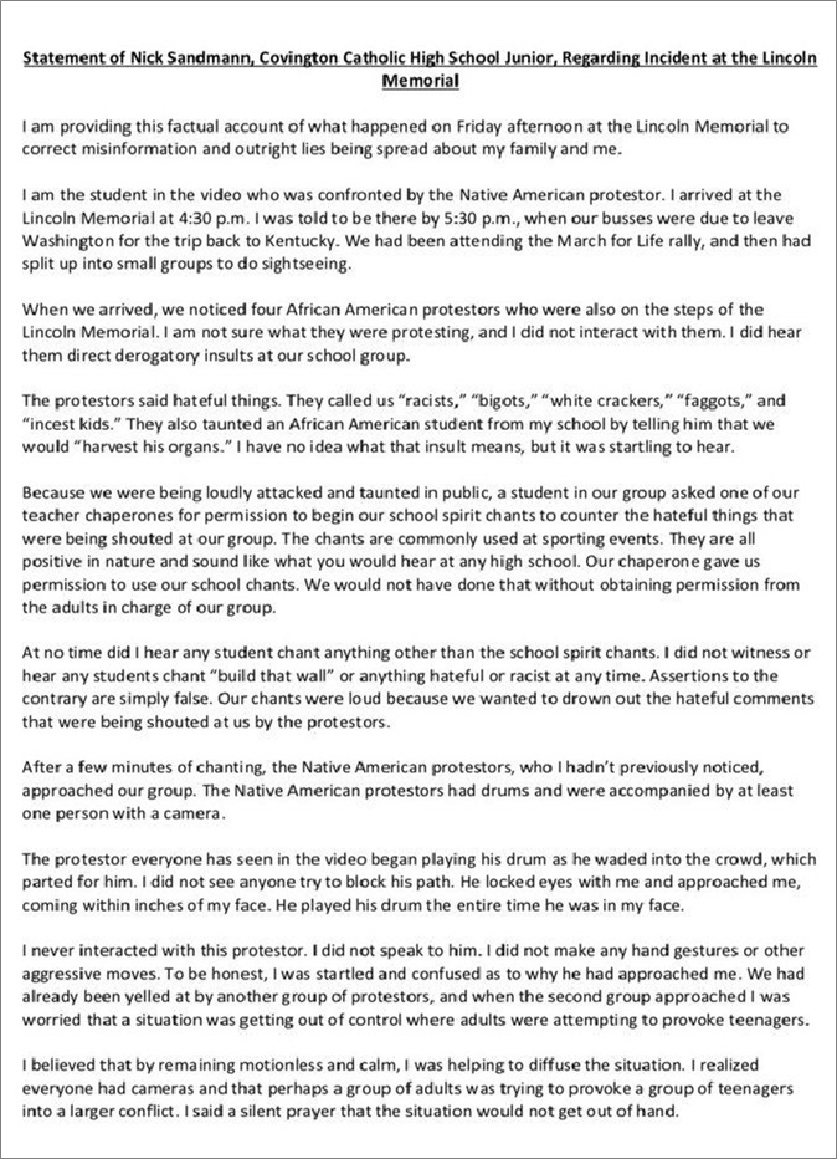
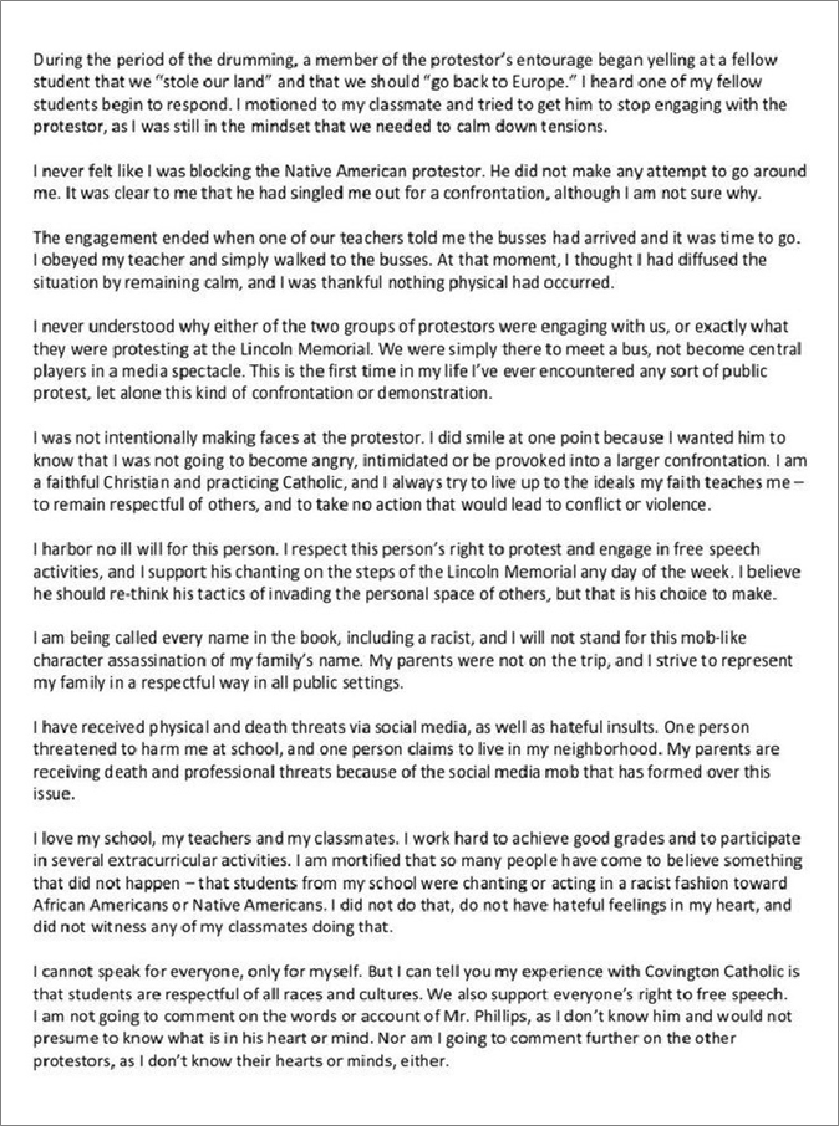
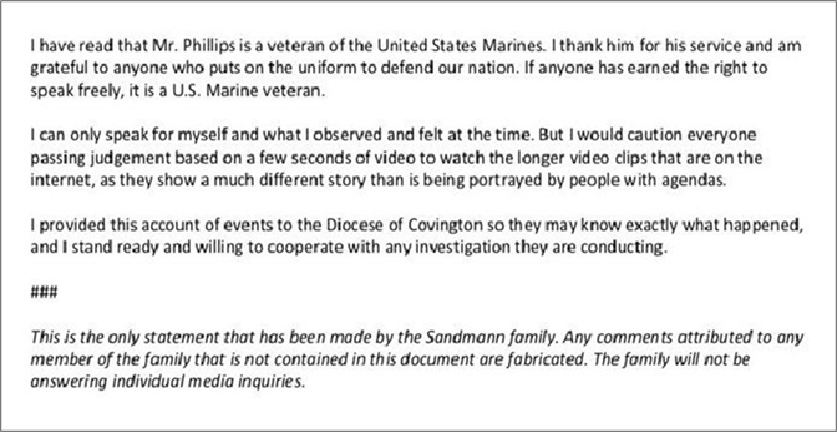

I attended the March for Life last week but saw nothing of
the episode that seems to have come to define it in the public mind: the alleged altercation between the students from Covington Catholic High School and a Native American war veteran.
Those who heard only the first draft of the story — concocted on the basis of a slickly edited video on Twitter — are left with the impression that the students wearing MAGA caps assailed this sexagenarian hero and subjected him to abuse. Those few who viewed the full video know that something close to the opposite occurred.
Most of the media outlets who ran with the initial version appear to have been too busy to catch up with the correction, so
the Twitter mob that sought to destroy those boys and all belonging to them — and forced an apology from the boys’ teachers and diocese before the truth emerged — got to decide the tone and meaning of the March for Life in the minds of most of those who took in anything at all about it.
The problem indicates an absence of adulthood:
- Nobody is capable of summoning up the courage and authority to clap his hands and shout “Stop!” as evils are perpetrated in plain sight.
- Of course, the episode also confirms something we ought to have absorbed years ago: that Twitter is a vile, decivilizing instrument.
In the not too distant future, should there be any sane and sentient adults capable of sifting through the ashes of the one-time Christian West, they will almost certainly conclude that it was
Twitter, the generator of vile and hateful mobs, wot dunnit. Yet we watch with no more than a shrug as each new low finds its place at the bottom.
Coming from Ireland (where abortion was declared legal just days beforehand, following last year’s voting down of the unborn child's right-to-life), I was especially attentive to the march. It was an overwhelmingly positive occasion.
Along with reports of the continuing decline of abortion in the United States, it gave me enormous hope that perhaps my country may one day be diverted from its present disastrous path. I went home greatly buoyed up, but with a couple of reservations.
One reservation I expressed the first time I attended the march, a decade ago:
The overwhelming presence of religious slogans and iconography prevents the meaning of the march from deeply penetrating a secular society that rejects this language. The eyes of the momentarily curious glance off such symbols: nothing to see there.
We know the meanings of these symbols, and the connection they have to the meaning of everything. People do not simple-mindedly oppose abortion because they are “religious” — they see the killing of unborn children as self-evidently barbarous. Our lives derive from (let us put it in vaguely secular terms) the force that generates reality, and the integrity of this process is central to understanding why abortion is a great evil.
To speak thinly — and derivatively — of that process as purely a matter of “human rights” is evasive and inadequate by comparison, and yet different words are needed to address the world beyond Capitol Hill.
The argument I made a decade ago is a tactical one, a plea for pragmatism in the face of the great evil that is destroying a civilization rendered insensate by secular ineloquence and mendacity. It would be profoundly wrong — and counterproductive —to propose a solution centered on removing all those Christian slogans and icons, but we need to translate their messages into secular language, however narrow and unresponsive that language may be.
My second hesitation goes to the roots of the incident involving the Covington students. In no sense do I blame those boys for what happened.
- They were set up and earmarked for evisceration on Twitter and in the so-called American media, an entity exceeded in malevolence only by the media of my own country.
-
The aim, of course, was to create a Cultural Marxist trope —originalist omnipotent victim v. pimpled patriarchs-in-waiting — to discredit the March for Life, which remains a drum beaten under the nose of the death culture of modern media because the operators of these scrofulous entities cannot bear to notice the genocide under their noses.
The exuberance and good humor of the boys seems to have been what attracted the attentions of the various malcontents the Covington boys ran foul of. Though I have no criticism to make of those boys, I respectfully submit that the episode supports a feeling I had about the march in general: Its tone has become unmoored from the gravity of its subject matter.
Like anyone else, my wife and I were in a happy mood when we set out for the march. The buzz when we arrived at the Mall was extraordinary and there appeared to be considerably more people present than the last time I attended — upwards of half-a-million. People were standing around chatting and laughing, sipping coffee, telling stories, making each other laugh. Many of them were young and exuberant despite having traveled for hours on cramped coaches. Their numbers brought great joy to the clouded souls of these two Irish pilgrims.
But as the march edged its way toward Constitution Avenue, and the gaiety continued, I began to think that maybe this was not the best way to mark the gravity of this Holocaust of our time. I could see that the celebratory mood — celebratory of undoubted achievements of the American pro-life movement — was in a sense justified and essential to the continuing success of the event. But I also realized that
the march has become more a celebration of pro-life energies than a commemoration of abortion victims. The unbroken atmosphere of joyousness begins to wear thin after a while.
I have a proposal to make that I believe could alter the tone and mood of the march — in a way that might arrest a media and public mindset that simply glazes over as the march goes by.
- It may be time the march was transformed into a more somber confrontation of America's doublethink in the face of the abortion apocalypse.
The march requires an injection of solemnity, and the idea I tumbled upon comes from one of the most striking styles of protest I have observed: that of the Sentinelle in Piedi (the Standing Sentinels) a movement that erupted in Italy during the public controversy that attended the introduction of gay civil unions not long ago.
This informal movement — comprising men and women, young and old, students and grandparents, families and individuals — took to Italian streets in 2016 to defend the ecology of family life, assembling in piazzas across the country, each protestor simply standing there reading silently from a book he or she had brought along. Participants were arranged in the form of a checkerboard, one meter away from each other.
Something akin to this might work well at some juncture of the March for Life. The question is what book to read — the Bible is in one sense the right book, but in another not. The U.S. Constitution is out for different reasons.
My proposal is this: Very soon, the pro-life movement should organize a nationwide — maybe even worldwide — competition for a children’s short story that somehow expresses the gravity of the abortion issue and that is appropriate for young children, a story of death-before-life.
The winning entry would then be printed in book form, to be distributed to attendees at next year’s March for Life. At a certain juncture, the attendance would lapse into silence, each person holding the book up for the world to see. Then, after a suitable prearranged pause, the crowd would begin to read the story aloud as one person — a bedtime story for the millions of children whose lives have been stolen by abortionists and their apologists all over the world.
John Waters is an Irish writer and commentator, the author of nine books, and a playwright.
From Bishop Barron, a reflection on the evil mob mentality that the Internet too often generates these days, but IMHO, he errs hugely if he thinks that the social media adepts who unleash their satanic passions could curb the groupthink reflex that drives them - not that they would want to at all!
The Internet and Satan’s game
by Bishop Robert Barron

January 22, 2019
By now the entire country has seen a video of a supposedly racist confrontation, in front of the Lincoln Memorial, between a grinning young high school student and a Native American elder, chanting and beating a drum. The immediate and ferocious judgment of the internet community was that the boy was effectively taunting and belittling the elder, but subsequent videos from wider angles as well as the young man’s own testimony have cast considerable doubt on this original assessment.
My purpose in this article is not to adjudicate the situation, which remains,
at best, ambiguous, even in regard to the basic facts. ['At best ambiguous'? That's a cop-out, Your Excellency!] It is to comment, rather, on
the morally outrageous and deeply troubling nature of the response to this occurrence, one that I would characterize as, quite literally, Satanic.
When the video in question first came to my attention, it already had millions of views on Facebook and had been commented upon over 50,000 times. Eager to find out what this was all about, I began to scroll through the comments.
- They were practically one hundred percent against the young man, and they were marked, as is customary on social media, by stinging cruelty. - As I continued to survey the reactions, I began to come across dozens urging retribution against the boy, and then dozens more that provided the addresses and email contacts of his parents, his school, and his diocese.
- I remember thinking, “Oh my goodness, do they realize what they’re doing? They’re effectively destroying, even threatening, this kid’s life.”
At this point, my mind turned, as it often does today, to René Girard. The great Franco-American philosopher and social commentator is best known for his speculations on what he called
the scapegoating mechanism. Sadly, Girard maintained, most human communities, from the coffee klatch to the nation state, are predicated upon this dysfunctional and deeply destructive instinct.
Roughly speaking, it unfolds as follows.
- When tensions arise in a group (as they inevitably do), people commence to cast about for a scapegoat, for someone or some group to blame.
- Deeply attractive, even addictive, the scapegoating move rapidly attracts a crowd, which in short order becomes a mob.
- In their common hatred of the victim, the blamers feel an ersatz sense of togetherness.
- Filled with the excitement born of self-righteousness, the mob then endeavors to isolate and finally eliminate the scapegoat, convinced that this will restore order to their roiled society.
At the risk of succumbing to the
reductio ad Hitlerum fallacy, nowhere is the Girardian more evident than in the Germany of the 1930s.
Hitler ingeniously exploited the scapegoating mechanism to bring his country together — obviously in a profoundly wicked way.
Girard’s theory was grounded in his studies of Shakespeare, Dostoevsky, and other literary figures, but his profoundest influence was the Bible, which not only identified the problem, but showed the way forward.
Take a good, long look at the story of the Woman Caught in Adultery in the eighth chapter of John’s Gospel to see what Girard saw regarding both the sin and the solution. It is surely telling that one of the principal names for the devil in the New Testament is
ho Satanas, which carries the sense of the accuser.
And how significant, thought Girard, that it is precisely
ho Satanas who offers all of the kingdoms of the world to Jesus, implying that all forms of human community are tainted, at least to a large degree, by the characteristically Satanic game of accusation, blaming, scapegoating.
All of which brings me back to the incident in Washington and the nasty reaction to it on the internet. I have used the internet to great positive effect in my evangelical work for many years; so I certainly don’t agree with those who denounce it in an unnuanced way.
However, there is something about social media comboxes that make them a particularly pernicious breeding-ground for Girardian victimizing. Perhaps it’s the anonymity, or the ease with which comments can be made and published, or the prospect of finding a large audience with little effort — but these forums are, increasingly, fever swamps in which hatred and accusation breed.
When looking for evidence of the Satanic in our culture, don’t waste your time on special effects made popular by all of the exorcism movies. Look no further than your computer and the twisted “communities” that it makes possible and the victims that it regularly casts out.
A few weeks ago, the
Wall Street Journal published a piece on me and my work. The author referred to me as “the Bishop of the Internet,” a title which I find more than a little strange. But for the moment, I’m going to claim it, only so I can make a pastoral pronouncement to all those who use social media.
- When you’re about to make a comment, ask yourself a very simple question: “Am I doing this out of love, out of a sincere wish for the good of the person or persons I’m addressing?”
- If not, shut up.
- If it becomes clear that your comment is simply spleen-venting, scapegoating, or virtue-signalling, shut up.
[Very unrealistic proposals to make! Groupthink - the mob mentality favored by the Internet in this case - has never been characterized by prudence. Because groupthink is a reflex that is conditioned into the mindset of those who follow it, and they do so blindly, believing that being part of a huge consensus automatically makes that consensus right. No one 'thinks' when carrying out a reflex reaction!]
The internet can be a marvelous tool, and it can be a weapon used for Satanic purposes. Applying the test of love can very effectively undermine the scapegoating mechanism and drive the devil out.
[Modificato da TERESA BENEDETTA 24/01/2019 03:02]